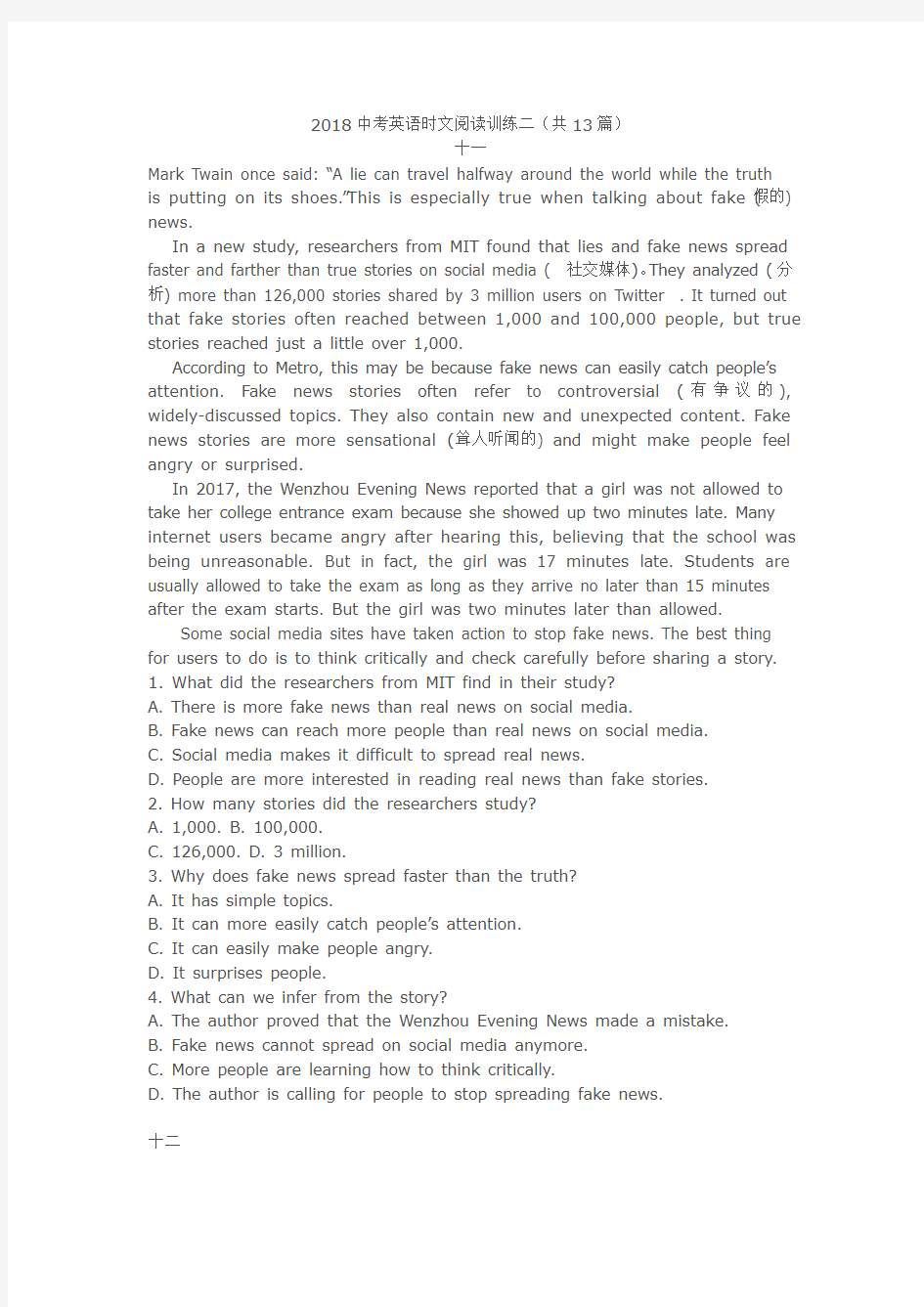中考英语时文阅读与训练押题含答案

- 1、下载文档前请自行甄别文档内容的完整性,平台不提供额外的编辑、内容补充、找答案等附加服务。
- 2、"仅部分预览"的文档,不可在线预览部分如存在完整性等问题,可反馈申请退款(可完整预览的文档不适用该条件!)。
- 3、如文档侵犯您的权益,请联系客服反馈,我们会尽快为您处理(人工客服工作时间:9:00-18:30)。
2018中考英语时文阅读训练二(共13篇)
十一
Mark Twain once said: “A lie can travel halfway around the world while the truth is putting on its shoes.”This is especially true when talking about fake (假的) news.
In a new study, researchers from MIT found that lies and fake news spread faster and farther than true stories on social media (社交媒体)。They analyzed (分析) more than 126,000 stories shared by 3 million users on Twitter. It turned out that fake stories often reached between 1,000 and 100,000 people, but true stories reached just a little over 1,000.
According to Metro, this may be because fake news can easily catch people’s attention. Fake news stories often refer to controversial (有争议的), widely-discussed topics. They also contain new and unexpected content. Fake news stories are more sensational (耸人听闻的) and might make people feel angry or surprised.
In 2017, the Wenzhou Evening News reported that a girl was not allowed to take her college entrance exam because she showed up two minutes late. Many internet users became angry after hearing this, believing that the school was being unreasonable. But in fact, the girl was 17 minutes late. Students are usually allowed to take the exam as long as they arrive no later than 15 minutes after the exam starts. But the girl was two minutes later than allowed.
Some social media sites have taken action to stop fake news. The best thing for users to do is to think critically and check carefully before sharing a story.
1.What did the researchers from MIT find in their study?
A. There is more fake news than real news on social media.
B. Fake news can reach more people than real news on social media.
C. Social media makes it difficult to spread real news.
D. People are more interested in reading real news than fake stories.
2. How many stories did the researchers study?
A. 1,000.
B. 100,000.
C. 126,000.
D. 3 million.
3. Why does fake news spread faster than the truth?
A. It has simple topics.
B. It can more easily catch people’s attention.
C. It can easily make people angry.
D. It surprises people.
4. What can we infer from the story?
A. The author proved that the Wenzhou Evening News made a mistake.
B. Fake news cannot spread on social media anymore.
C. More people are learning how to think critically.
D. The author is calling for people to stop spreading fake news.
十二
It is always fun to talk about cultural differences between China and America. Some of them can be so small that we don’t even notice.
When my host sister came to China to travel last summer, the thing she complained about most was that Chinese restaurants didn’t offer enough ice cubes (冰块) for her. She and her friends like to fill their glasses with ice cubes and then add their drinks. As she said, “We were all especially happy when we found a place in the hotel that offered free ice cubes.”
Another interesting difference is that Americans believe that being tan (棕褐色的) looks good. I myself have really tan skin compared to most Chinese, which always leads to people making fun of me. However, it is the opposite in America, where they make fun of people with pale (苍白的) skin. After an eight-day trip to Florida with my host family, they compared themselves with each other to see who was the most tan. I don’t really care to talk about being tan with Americans because there’s no surprise that I am the most tan, even if I am hanging out with my Chinese friends.
As people around the world have more contact with each other with the help of technology, the need to explore other cultures is growing stronger. Traveling or studying in another country is a good way to meet this need
1.What did the author’s host sister complain about most when she traveled in China?
A. She didn’t like Chinese food.
B. People laughed at her skin color.
C. Restaurants didn’t offer enough ice cubes.
D. It was too hot in the summer.
2. What do we know from the author’s experience abroad?
A. Chinese people like being tan.
B. Americans prefer pale skin to tan skin.
C. Americans laugh at people with pale skin.
D. Her American friends made fun of her tan skin.
3. What is a good way to learn about other cultures, according to the last paragraph?
A. Studying or traveling abroad.
B. Watching foreign TV programs.
C. Making foreign friends.
D. Using new technology.
4. The story is mainly about _____.
A. cultural differences
B. Chinese eating habits
C. skin color in China and the US
D. travel tips for foreign countries
十三
If you need to prove who you are in China, you’ll usually use an ID card (identity card, 身份证). It shows your name, date of birth, address, nationality, photo and ID number. But now, you can prove your identity using your smartphone.
On April 17, Alipay introduced its first electronic ID card. The card is a digital (电子的) version of a real ID card and is recognized by the Ministry of Public Security (公安部), the Xinhua News Agency reported.
It’s quite easy to get an electronic ID card by using the Alipay app. Users can simply select “Web ID” under “Certificate (证件)” in the “Card Wallet” menu and scan (扫描) their faces, according to Beijing Youth Daily.
The electronic ID card is now being used in Hangzhou, Quzhou and Fuzhou, according to The
